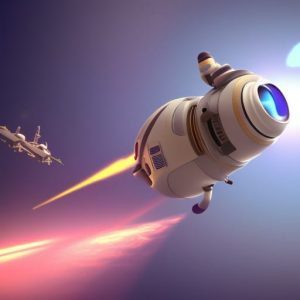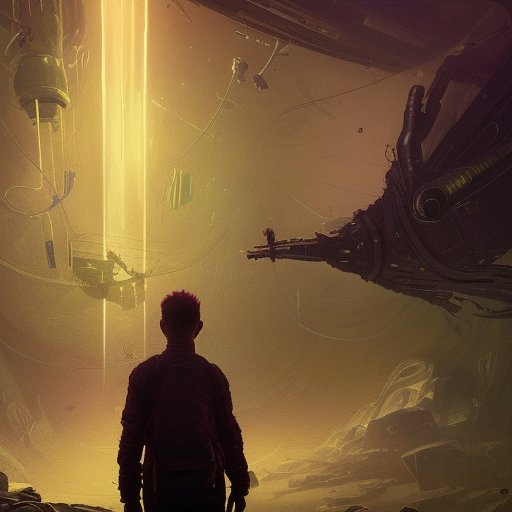
The future of space travel is a topic of great interest and excitement, with the potential for new breakthroughs and discoveries beyond our wildest imaginations. In this article, we explore the current state of space travel and the possibilities and challenges that lie ahead. We examine advances in spacecraft design and propulsion, as well as the increasing role of robotics and artificial intelligence in space exploration. We also discuss the future of human space exploration, including the goal of establishing a permanent human presence beyond Earth and the search for signs of extraterrestrial life. While the challenges of space travel cannot be ignored, the potential for new frontiers of knowledge and exploration is vast. With continued investment in research and innovation, we may one day unlock the secrets of the universe and explore new horizons beyond our own planet.
I. Introduction
Space travel has long been a subject of fascination in science fiction literature, inspiring countless writers to imagine worlds beyond our own and technologies that would allow us to explore them. From Jules Verne’s From the Earth to the Moon to Frank Herbert’s Dune, these stories have captured our imagination and sparked our curiosity about what lies beyond the confines of our planet.

In reality, we’ve been exploring space for over half a century, with both manned and unmanned missions sending probes and people to the moon, Mars, and beyond. But despite these achievements, space travel remains a daunting challenge, requiring cutting-edge technology and vast resources.
As we look to the future, the possibilities for space travel are both exciting and daunting. From the prospect of faster-than-light travel to the colonization of other planets, there is no shortage of potential frontiers to explore. But the challenges are just as significant, with questions around sustainability, the role of AI and robotics, and the impact on human evolution.
In this article, we’ll explore the future of space travel, looking at the possibilities and challenges that lie ahead. From the current state of space exploration to advances in spacecraft design and propulsion, we’ll examine the technologies that will make space travel possible in the coming decades. We’ll also consider the role of AI and robotics in space travel and the potential for interstellar travel and colonization. Ultimately, we’ll argue that space travel has the potential to shape the future of humanity, and that continued investment in space exploration and research is essential to realizing this potential.
II. The current state of space travel
Despite the challenges involved, space travel has been a reality for over 60 years, with both unmanned and manned missions sending spacecraft to explore our solar system and beyond. As of 2023, there are several ongoing missions that are exploring our solar system, such as the Mars Rover, Juno mission to Jupiter, and the New Horizons mission to Pluto.
Unmanned spacecraft have been crucial in the exploration of our solar system, allowing us to gather data and images from planets, moons, and asteroids that are beyond the reach of manned missions. These spacecraft have helped us to understand the formation of our solar system, the geology of other planets, and the potential for life beyond Earth.

Manned missions, on the other hand, have been limited to the vicinity of our planet, with the International Space Station being the primary destination for human crews. However, these missions have still yielded valuable insights into the effects of microgravity on human health and the development of technologies for long-duration spaceflight.
Despite these achievements, space travel remains a daunting challenge. The cost and complexity of launching and maintaining spacecraft are significant, and the technology required for long-duration missions beyond our planet is still in development. Additionally, the lack of a clear commercial or scientific return on investment has made space exploration a challenging proposition for many governments and private organizations.
Looking ahead, the current state of space travel provides both inspiration and caution. While we have achieved significant progress in exploring our solar system, the challenges of space travel remain significant, and much work is needed to make the exploration of other planets and interstellar space a reality. Nonetheless, the prospects for the future of space travel are exciting, with the potential for new breakthroughs in propulsion, robotics, and AI that could revolutionize the way we explore and understand our universe.
III. The Future of Space Travel: Possibilities and Challenges
Looking ahead, the future of space travel is full of possibilities and challenges. From faster-than-light travel to the colonization of other planets, there are many frontiers waiting to be explored. However, the challenges of making space travel a reality remain significant, and new technologies and innovations will be needed to overcome them.
One of the most exciting possibilities for space travel is the prospect of faster-than-light travel. While this has long been a staple of science fiction, recent research into concepts such as Alcubierre drives and wormholes has suggested that such technologies may be possible in the future. These technologies would allow us to travel vast distances in space in a matter of days or weeks, opening up new frontiers for exploration.

Another possibility for space travel is the colonization of other planets. With the depletion of resources on Earth and the potential for catastrophic events such as asteroid impacts or global pandemics, the colonization of other planets may become a necessity for the survival of our species. Terraforming, the process of transforming a planet to make it habitable for humans, is a potential technology that could make this a reality. However, the challenges of creating sustainable habitats and ecosystems on other planets remain significant.
Alongside these possibilities, space travel also presents significant challenges. The issue of sustainability in space is a pressing concern, with the need to develop technologies for recycling and reusing resources in order to support long-duration missions beyond our planet. The role of robotics and AI in space exploration also raises ethical questions around autonomy and the potential replacement of human crews with machines.
As we look to the future of space travel, there is no shortage of possibilities and challenges. However, with continued investment in research and innovation, it is possible that we may one day be able to explore the furthest reaches of our universe and colonize other worlds. The future of space travel is a frontier waiting to be explored, and the potential for new breakthroughs and discoveries is limitless.
IV. Advances in Spacecraft Design and Propulsion
Advances in spacecraft design and propulsion are crucial for the future of space travel. These technologies will enable us to explore new frontiers in space and make long-duration missions beyond our planet a reality. In recent years, there have been several exciting developments in this field.
One of the most promising advances in spacecraft design is the development of reusable rockets. Companies such as SpaceX and Blue Origin have made significant progress in creating rockets that can be reused for multiple missions, reducing the cost of launching payloads into space. This has the potential to make space travel more accessible and affordable, opening up new opportunities for commercial and scientific missions.
In addition to reusable rockets, there have been significant advances in the development of electric propulsion systems. These systems use electrically charged particles to propel spacecraft, providing greater efficiency and enabling longer-duration missions. This technology is already being used in several space missions, such as NASA’s Dawn mission to the asteroid belt and the European Space Agency’s BepiColombo mission to Mercury.

Another exciting development in spacecraft design is the use of inflatable habitats. These habitats can be easily transported to space and inflated to create a living space for astronauts. This technology has the potential to make long-duration missions beyond Earth more feasible, as it reduces the need for large, heavy habitats that are difficult to transport.
Advances in propulsion technology are also crucial for the future of space travel. While chemical rockets have been the primary means of propulsion for spacecraft, they have significant limitations in terms of speed and distance. However, there have been significant advances in alternative propulsion systems, such as ion thrusters and nuclear propulsion. These technologies have the potential to enable faster and more efficient space travel, making long-distance missions to other planets and beyond more feasible.
V. The Role of Robotics and Artificial Intelligence in Space Travel
Robotics and artificial intelligence (AI) are playing an increasingly important role in space travel. From assisting with scientific research to managing spacecraft operations, these technologies are transforming the way we explore space.
One of the primary benefits of robotics and AI in space travel is their ability to perform tasks that are too dangerous or difficult for humans. For example, robotic rovers such as NASA’s Curiosity have been used to explore the surface of Mars, collecting valuable scientific data and sending it back to Earth. These rovers can operate in harsh environments and perform tasks such as drilling and sample collection, enabling scientists to study the planet in detail.

In addition to scientific research, robotics and AI are also being used to manage spacecraft operations. Spacecraft are becoming increasingly complex, and the use of AI systems can help to manage the large amounts of data and information that are generated during missions. This can help to reduce the workload of human crews and ensure that spacecraft are operating at maximum efficiency.
The use of robotics and AI in space travel also raises ethical questions around autonomy and the potential replacement of human crews with machines. While robots and AI systems can perform many tasks, they lack the ability to make complex decisions and respond to unexpected situations in the same way that humans can. As such, it is important to consider the role of human crews in space travel and the potential impact of automation on the workforce.
Looking ahead, the role of robotics and AI in space travel is only set to increase. With continued investment in research and innovation, it is likely that we will see new breakthroughs and applications of these technologies in the years to come. Whether assisting with scientific research or managing spacecraft operations, robotics and AI are transforming the way we explore space and unlocking new possibilities for the future of space travel.
VI. The Future of Human Space Exploration
Human space exploration has always been a dream of humanity. From the first steps on the moon to the potential colonization of Mars, the future of human space exploration is full of exciting possibilities.
One of the primary goals of human space exploration is to establish a permanent human presence beyond Earth. This will require the development of new technologies and capabilities to support long-duration missions, including life support systems, habitats, and propulsion systems. Companies such as SpaceX and NASA are already working on developing these technologies, with plans to establish a permanent human presence on Mars in the coming decades.

Another important goal of human space exploration is to expand our knowledge of the universe and search for signs of extraterrestrial life. NASA’s upcoming James Webb Space Telescope, set to launch in 2021, will help to answer some of the biggest questions about the origins of the universe and the potential for life beyond Earth. In addition, the search for habitable exoplanets and the study of the Martian environment are also critical areas of research for human space exploration.
However, human space exploration also faces significant challenges. Long-duration missions beyond Earth pose significant risks to human health, including radiation exposure and the psychological challenges of isolation and confinement. These challenges will need to be addressed through the development of new technologies and protocols to support the physical and mental health of astronauts.
In addition, the cost of human space exploration is a significant barrier. As missions become more complex and ambitious, the costs of development and operations are increasing. This has led to a growing interest in commercial space travel and the potential for private investment in space exploration.
VII. Conclusion
The future of space travel is full of exciting possibilities and challenges. Advances in spacecraft design and propulsion, as well as the increasing role of robotics and AI, are transforming the way we explore space. The future of human space exploration is also bright, with the potential for new breakthroughs and discoveries beyond Earth.

However, the challenges of space travel cannot be ignored. The cost of developing and operating space missions remains high, and the risks to human health and safety are significant. Addressing these challenges will require continued investment in research and innovation, as well as collaboration between governments, private companies, and academic institutions.
Despite these challenges, the potential for space travel to unlock new frontiers of knowledge and exploration is vast. From discovering new planets to establishing a permanent human presence beyond Earth, the possibilities are endless. As we continue to push the boundaries of what is possible, the future of space travel is limited only by our imagination and our willingness to explore.







This is a really cool article lol